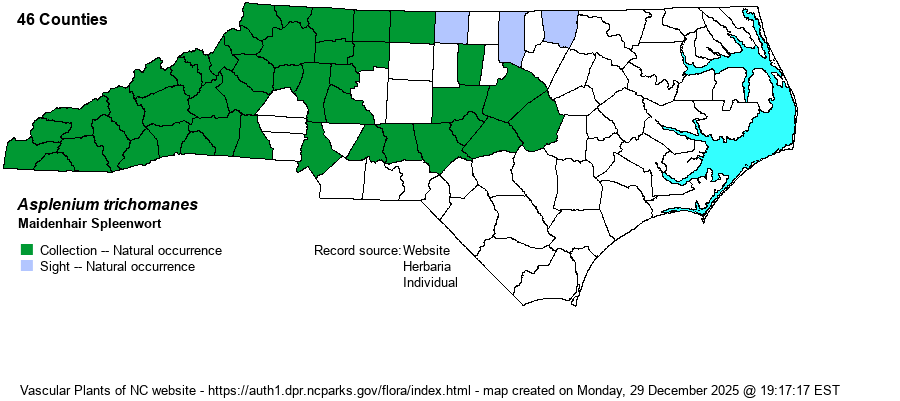| Author | L. | |
| Distribution | Throughout the Mountains. Present over most of the Piedmont, ranging east to Warren, Wake, and Johnston counties.
This is a montane species, mostly found in the Appalachians, less so in the Ozarks and other ranges. It ranges from eastern Canada south to central AL and northern AR. | |
| Abundance | Infrequent to fairly common (though somewhat restricted in habitat) in the Mountains; mostly uncommon and local in the Piedmont, but generally rare in the far northeastern Piedmont. | |
| Habitat | This is a rock-inhabiting species of damp and shaded places, always where the rocks are calcareous or mafic (with high pH soil in the cracks and crevices). It may grow under overhangs, or on flat to sloping rocks, and is not strictly limited to vertical rock faces; however, the sites must be well shaded. | |
| Phenology | Fruits from May to October. | |
| Identification | This is perhaps the smallest Asplenium in the state, at least in size of the pinnae. Several to many fronds grow in a clump, with a shining brown stipe about 1-2 inches long, and an evergreen blade that is very narrow and oblong in overall shape, about 6-7 inches long but just 2/3-inch wide at best. The blade is only pinnately divided, with 9-20 pairs of opposite to mostly opposite pinnae. Each pinna is round to ovate, barely 1/4-inch long and 1/6-inch wide, with small scalloping on the margins (but no lobes). There are about 6 sori under each pinna, diagonal to the midrib. This is an easy Asplenium to identify, as similar ones have the pinnae oblong in shape and 2 times or more as long as wide. At times you must look carefully on a rock face to even see this species, as some individuals in tiny cracks can be very small indeed, barely 2-3 inches long. | |
| Taxonomic Comments | None
| |
| Other Common Name(s) | None | |
| State Rank | S4 | |
| Global Rank | G5 | |
| State Status | | |
| US Status | | |
| USACE-agcp | FAC link |
| USACE-emp | FAC link |

